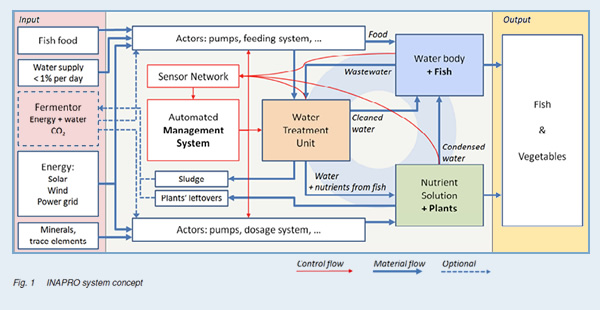PROJECT OVERVIEW
THE CHALLENGE
The collaborative project “INAPRO” aims at developing a model and demonstrating the application of aquaponics in rural and urban areas in Europe and abroad.
INAPRO innovates conventional approaches to aquaponics through the development of a computer model and the integration of cutting edge technologies to save water and optimise energy and nutrients management.
The INAPRO system allows the production of healthy, local and sustainable food in a resource efficient way responding to the 21st century great challenge of food security. INAPRO concurs also to solve the water security issue and thus contributes to the recent EU strategies under the new Horizon 2020 programme.
INAPRO is linked to the EIP Water Action group “Water & Irrigated agriculture Resilient Europe” and therefore supports the European Innovation Union.
PROJECT OBJECTIVES
INAPRO develops an innovative and sustainable aquaponic system solution. Aquaponics is a green technology that couples aquaculture (production of fish) with horticulture (production of vegetables) while reusing freshwater, nutrients and CO2.
In an aquaponic system, the nutrient-rich water from the fish unit is used as fertilizer for the hydroponically grown crops, which therefore reduces the sewage of the fish component. Aquaponics reduces the water consumption and footprint compared to single fish and plant production. Despite its great potential, large integrated aquaponic solutions are not easily available on the market, mainly because they lack of stability, economic profitability, and technical and technological standardisation.
INAPRO aims at a real breakthrough toward commercialisation by developing a model-based optimised aquaponic system. Developing a modular solution - scalable and adaptable to local conditions - will strengthen standardization in this field.
The INAPRO system allows an optimised reuse of water resources, a minimisation of waste effluents as well as the recovery of nutrients from waste water together with a minimisation of energy demand, of infrastructure requirements and operating costs.
INAPRO aims at mobilising the industry and Member States to promote its new and innovative technical and technological approach to aquaponics. By working together within a well-developed network of stakeholders from science and industry, especially SMEs, the project intents to cover the whole value chain: from research to markets, from modelling and experimental research to demonstration objects at pilot scale; from science to policy, business and public.
INAPRO will open new market opportunities and improve the market access inside and outside of Europe for producers, technology suppliers and end-users.
METHODOLOGY
INAPRO innovates conventional approaches to aquaponics through the development of a model-based system for the management of water, energy and nutrients. The modelling approach will allow the optimisation of all details in design, construction, integration and operation of the system, proving the technical and economic feasibility of INAPRO.
Moreover, the model-based INAPRO system will be integrated with innovative technological solutions such as a double water recirculating system (one for the aquaculture and one for the horticulture part), a cooling trap system to allow the collection of the evapo-transpirated water generated by the plants, optimised filter systems and wastewater treatment as well as a remote diagnosis and control technology system.
From the beginning, the project will disseminate the most important project results and outcomes to manufacturing SMEs, end-users and all other stakeholders.

EXPECTED RESULTS
The results to be provided by the INAPRO project are the following:
1. Development of a computer model and integration of innovative technologies for an improved management of the system
2. Construction of aquaponic greenhouses in different locations to demonstrate and prove the INAPRO concept
- Installation of an independent recirculating systems for aquaculture and hydroponic
- Installation of a one-way connection of the aquaculture and horticulture part to transfer the nutrient-rich fish water to the plants.
- Integration of cooling traps to recuperate the evapo-transpirated water from the plants
- Integration of optimised filter systems and wastewater treatment
- Integration of alternative water and energy sources (rainwater, renewable energy sources)
- Integration of intelligent sensors, control and manufacturing execution system
3. Production of sustainable food with a low carbon and water footprint
4. Enhanced nutrients and energy retrieval from waste
5. Development of standardised INAPRO products, process and management system
6. Successful dissemination and exploitation activities carried out and documented
- Market analyses proving the visibility and acceptance of INAPRO
- Creation of new market opportunities for European SMEs
- International outreach of the project in terms of research, market and policy impact
